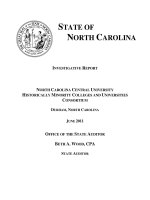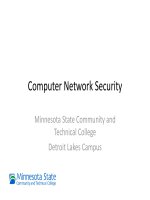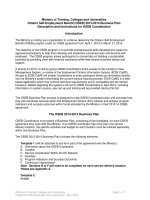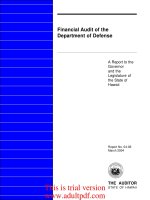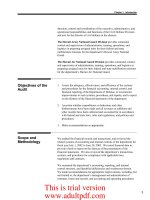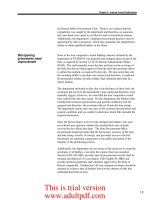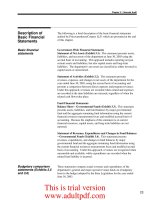Minnesota State Colleges and Universities Selected Scope Audit of the Student Information System Tuition and Accounts Receivable Module as of June 1999_part2 pot
Bạn đang xem bản rút gọn của tài liệu. Xem và tải ngay bản đầy đủ của tài liệu tại đây (114.02 KB, 10 trang )
MnSCU – Student Information System (SIS) Application Review
8
Table 2-1
MnSCU Student Information System
Number of Users
Ability to Update:
Users
Tuition/Fee Rates 685
Registration
702
Collections
447
Waivers
415
Deferrals
453
Student Residency Code
436
Source: Auditor prepared from MnSCU Menu System Security Data.
• An excessive number of users were assigned incompatible security groups. We think that
cashiers should be restricted from posting sensitive transactions that allow manipulation
of recorded balances. Over 340 users assigned cashiering security privileges also had the
capability to alter registration information, waive or defer registration charges, adjust or
waive non-student accounts receivable balances, and change student residency codes
used in the tuition calculation.
• We noted that a number of users had excessive access to multiple institutions. We found
35 users who could update the rate tables from 2 to 36 MnSCU institutions. Similarly, 32
users could process waiver or deferment transactions, or initiate changes to student
residency codes used to calculate tuition and fee charges. Most of these users were
MnSCU system office employees in the Finance Unit as well as the Information
Technologies Service Unit. These employees may not require access to multiple colleges
or universities to perform their job responsibilities.
Recommendations
• MnSCU should adequately document access provided by each security group,
develop baseline security standards for job descriptions, document potentially
incompatible security groups, and identify effective methods to mitigate risks
when an institution cannot separate duties.
• MnSCU should develop procedures to monitor system access and investigate
excessive, as well as incompatible, clearances that currently exist. System
access privileges should be based on job responsibilities.
MnSCU – Student Information System (SIS) Application Review
9
Chapter 3. System Processing
Chapter Conclusions
MnSCU designed a computerized accounts receivable application that
integrates with other Integrated Student Records System (ISRS) modules,
primarily accounting. Integrating the various registration, accounts receivable,
and accounting processes minimizes the risk of human input error and avoids
the need for duplicate entry or reconciling of independent subsystems. Using
the system databases, for the items tested, we found that the system properly:
• assessed tuition and fees based on registered credits;
• applied collections and financial aid funds to student accounts;
• maintained student accounts receivable balances; and
• posted the appropriate accounting entries.
However, we found that MnSCU has not developed some key management
control reports to address specific risks involved with certain sensitive
transactions. Also, negative receipt transactions create an unnecessary risk and
provide a poor audit trail.
The MnSCU Student Information System (SIS) interfaces registrations and collections to
calculate individual student accounts receivable balances. Figure 3-1 shows the processing
components included in the accounts receivable calculation.
A critical result of these processes is that the system also initiates the automated posting of cash,
tuition revenue, and accounts receivable balances into the MnSCU accounting system.
Figure 3-1
Minnesota State Colleges and Universities
Student Accounts Receivable Processes
MnSCU – Student Information System (SIS) Application Review
10
Tuition and Fee Assessments
Tuition and fees are assessed and billed to students automatically by the MnSCU Accounts
Receivable module. Each night the system recalculates student tuition/fee charges for new
registration activity. If a student registered for a course, the system checks the course record to
determine the instructional unit that the course is tied to. An instructional unit, set up in the
Curriculum module, is the link between the Course and the Accounts Receivable module. Next,
the system checks the system tables to determine which tuition group is tied to the particular
instructional unit. A tuition group allows the institution to take a number of instructional units,
which will be billed in the same manner, and combine them into a group. Once the system has
determined the instructional unit and tuition group, it checks the student record to determine the
student’s state of residency. The system then checks the course record in Term Course to
determine if it is a graduate or undergraduate course. Next, the system checks the system tables
to determine which rate has been entered for the applicable tuition group, residency status, and
course level. Once the system has determine the appropriate rate, it checks the course record to
determine the number of credits that the course is worth and multiplies tuition rate by the number
of credits to calculate the student’s tuition bill. As a result of the tuition calculation, the system
also initiates posting of the appropriate tuition revenue accounting transactions.
Any one of three events could initiate the system tuition calculation. First, as discussed above,
new registration activity triggers a nightly batch process calculation. For this type of calculation
to occur, the student would have added or dropped a course in registration. Second, a cashier can
perform an immediate system calculation if a student pays tuition the same day as registering.
The cashier can prompt the system to recalculate that student’s bill only. Finally, the campus can
request a special recalculation of all students. For example, if a college needs to recalculate all
students, due to late entry of course fees or a late change in tuition rates, they can request this
process from their regional computer center.
Tuition and Fee Collections
Tuition and fee receipts generally come from either the student paying directly or student
financial aid. When a student pays directly, a cashier would collect the money and post the
receipt to the student’s account. The system applies the receipt to the student’s tuition and fee
charges in order of priority, which is pre-determined by each institution, and then posts the
appropriate accounting transactions. On a daily basis, cashiers should close out their cash drawer
and another individual should compare collections to receipts recorded in the system.
Funds applied is the process by which financial aid funds are posted against each student’s
outstanding tuition and fee charges. This process occurs in the evening in a batch process. Each
institution determines the frequency of the batch process. In all cases, financial aid funds applied
to student accounts are run after the tuition re-calculation process to ensure that new activity is
included. Each institution sets the order in which each type of financial aid is applied and the
order in which specific charges are offset by financial aid. Certain sources of financial aid may
have restrictions on their use requiring each institution to designate the charges that cannot be
paid for by each type of aid. For example, financial aid funds cannot be applied against
outstanding parking or library fines. Throughout the funds applied process, the system posts the
appropriate accounting entries impacting the tuition revenue and financial aid accounts.
MnSCU – Student Information System (SIS) Application Review
11
The funds applied process relies on financial aid award data stored in each institution’s database.
Depending on the institution, this data may come from different sources. MnSCU has developed
its own, fully integrated, Financial Aid module. For universities and colleges using this module,
awards are automatically stored in the institution’s database. MnSCU, however, has not required
its institutions to implement the module. The majority of institutions are using one of two other
PC-based systems: SAFE and SARA. MnSCU has written computer programs that upload, or
interface, detailed data from SARA and SAFE and post it to the financial aid awards table.
Students Accounts Receivable Balances and Reporting
As a result of the activity described above, and other processes, the system calculates an
accounts receivable balance for each student. MnSCU has developed some pre-defined reports
to help institutions identify and manage their unpaid accounts receivable balances. We also
noted that institutions have begun using their replicated databases for ad-hoc reporting purposes.
Audit Objectives and Methodology
The primary objectives of our review were to determine the adequacy of application processing
and controls ensuring the integrity of:
• tuition and fee assessments;
• tuition and fee collections, including student financial aid funds applied;
• student accounts receivable balances; and
• accounting transactions.
To address this objective we interviewed MnSCU staff from the system office and pilot
institutions, reviewed user documentation, and studied the related tables in the MnSCU databases
to gain an understanding of system controls and processing. We primarily utilized a database
query tool and the data stored in MnSCU’s replicated databases to determine whether logical
calculations were derived, student account balances are properly impacted, and the system
accurately posted the appropriate accounting transactions.
Conclusions
MnSCU designed a computerized accounts receivable application that integrates with
other Integrated Student Records System (ISRS) modules, primarily accounting.
Integrating the various registration, accounts receivable, and accounting processes
minimizes the risk of human input error and avoids the need for duplicate entry or
reconciling of independent subsystems. Using the system databases, for the items tested,
we found that the system properly:
- assessed tuition and fees based on registered credits;
- applied collections and financial aid funds to student accounts;
- maintained student accounts receivable balances; and
- posted the appropriate accounting entries.
MnSCU – Student Information System (SIS) Application Review
12
However, we found that MnSCU has not developed some key management control
reports to address specific risks involved with certain sensitive transactions. Control
reports would also assist management in making informed business decisions. Also,
negative receipt transactions create an unnecessary risk and provide a poor audit trail.
3. MnSCU has not developed key management reports to help institutions address specific
risks and aid management in making informed decisions.
MnSCU did not develop key reports to alert management to certain high-risk transactions and to
facilitate informed management decisions. Either standard production database reports or
replicated database queries are needed to effectively monitor or control certain financial
activities. Currently, standard reports that access the production databases do not identify these
transactions. Campuses can use replicated database queries to produce this information, but this
process may create additional risk and difficulty. Compiling information from replicated
databases requires users to have significant knowledge of relational databases, database
structures, and database query tools. It also increases the risk of inaccurate reports since users
can inappropriately screen or filter data. In addition, a key system flaw allows users with update
capabilities in the production database to also alter data in the replicated database producing
inaccurate results. We noted three key reports that would aid management in controlling tuition
revenue processing:
• The computerized accounts receivable application allows users to eliminate a student’s
tuition and fee charges by backdating registration cancellation records. MnSCU Policy
5.8 Refunds, Withdrawals, and Waivers allow institutions discretion when canceling
tuition charges. For example, a student is allowed to drop a class, without obligation, if
done prior to the institution’s established “drop date.” At any time, system users can
backdate a student’s drop date to reflect a date prior to the required drop date. These
transactions are particularly sensitive since they eliminate the student’s obligation and
reduce the amount earned by the institution. These transactions should be documented
and specifically authorized by management. MnSCU has not developed system reports
to alert management about the volume of these transactions.
• MnSCU has not developed waiver reports to help management monitor the validity and
extent of such transactions. We noted waivers totaling $4.4 million were posted during
fiscal year 1999. Waiver transactions are highly sensitive since they reduce or eliminate
a student or non-student charge and the amount due to the college. Examples include
employee waivers provided as a benefit in their bargaining agreement, student waivers
for medical reasons or significant personal reasons, or where a balance needs to be
adjusted as the result of an error. A report identifying waivers is critical because an
excessive number of users have the ability to produce these system transactions.
• MnSCU has not developed a standard accounts receivable aging report or write-off
report. Aging reports provide a valuable tool for management decisions on policies for
collecting delinquent accounts, as well as writing off old uncollectible balances. Write-
offs are particularly sensitive since they reduce the amount due to the institution. Similar
to other transactions that reduce the amount collected, write-offs need to be documented
and authorized.
MnSCU – Student Information System (SIS) Application Review
13
Recommendation
• MnSCU should develop key reports for cancelled registrations, waivers, and
uncollectible or written-off balances to help management make informed
decisions and mitigate the risk of unauthorized transactions occurring and
going undetected.
4. Negative receipt transactions provide a poor audit trail and create an unnecessary risk
exposure.
We noted a key risk resulted from the use of negative receipt transactions. These transactions
create a significant vulnerability since users that handle cash could potentially conceal theft.
Negative receipt transactions provide cashiers with the ability to manipulate the accounting
system to agree with the cash deposited. Any transaction that reduces the cash and revenue
collected should be documented and properly authorized by someone independent of the
collection process, typically a supervisor.
At the time of our audit, campus users could initiate a negative transaction using the receipts
screen normally used to process collections. For example, if a cashier recorded a $100 receipt,
but wanted to reduce it to $50, the accounting system would simply record a $50 decrease in
cash and revenue, providing a poor audit trail. Alternatively, if the system correction screen was
used, the accounting system would reverse the original transaction totaling $100 and also record
the correct transaction totaling $50, providing a sufficient audit trail.
MnSCU has recognized the high-risk nature of performing a negative transaction using a receipt
screen and has since removed that capability from two of the three security groups that
previously had it. We found that approximately 200 users had the remaining security group that
still allows this type of transaction. While removing the capability from two groups was an
improvement, we question the need to allow any user the ability of entering negative receipts on
a receipt screen rather than using the receipt correction screen.
Recommendation
• System users should be required to use the appropriate correction screens to
perform any reductions to receipt transactions.
MnSCU – Student Information System (SIS) Application Review
14
This page intentionally left blank.
MnSCU
Minnesota State Colleges & Universities
September 24, 1999
Mr. James Nobles
Legislative Auditor
Office of the Legislative Auditor
Centennial Building
658 Cedar Street
St. Paul, MN 55155
Dear Mr. Nobles,
This is in response to the Minnesota State Colleges and Universities Information Systems Application
Review of the accounts receivable module of the Integrated Student Information System (ISRS).
Development and implementation of the student information system (SIS) was an ambitious undertaking.
The system is necessary to provide a single integrated system that accurately and consistently determines
tuition and fee amounts for each student, applies collections and financial aid, and maintains student
accounts and posts accounting entries.
Please extend our thanks to Brad White, audit manager and Eric Wion, auditor-in-charge for their efforts in
this systems review. We are pleased that you found that the system accomplished these functions properly.
While we feel we have been successful in this endeavor we recognize the need for improvement. With the
last two institutions completing conversion in July we can devote more resources to remedying problems,
including those in your report.
We have already made significant improvements in our systems development efforts since the first
institutions implemented ISRS. We now have a quality assurance unit in place to test all systems changes
before they are placed in production. We have increased documentation of the business processes
supported by these systems. We have significantly extended the availability of detail system data through
the use of replicated databases. We have a very active user community that provides input to systems
decisions and helps set priorities for improvements. Our efforts are devoted to continually improving all of
the systems supporting MnSCU students and all of our institutions.
Our plans to address the audit findings are attached.
Warmest Regards,
Laura M. King
Vice Chancellor
Chief Financial Officer
Enc.
500 World Trade Center 30 East Seventh Street St. Paul, Minnesota 55101
651.296.8012 Facsimile 651.297.5550 TDD 651.282.2660
An equal opportunity educator and employer
MnSCU Information System Application Review
Response to findings
September 24, 1999
Recommendation 1: MnSCU should review and modify two key security groups that allow excessive
access to incompatible functions.
Response: Over the next month, after identifying all of those users assigned to these two security groups
we will notify them that the groups will be significantly altered to eliminate the incompatible accesses. We
will provide information on the access provided by related security groups. We will also instruct effected
institutions to review the access needs of the users involved and determine the appropriate security group
necessary to accomplish the user’s assigned duties.
We need to proceed with care to ensure that our actions don’t result in users being unable to perform their
job duties because they no longer have the necessary access. Thus, we cannot make the changes to the
security groups until necessary alternate security groups have been identified and activated for each
effected user. We expect to complete this process for the accounts receivable security group by the end of
October and for the second group by the end of November. Ken Niemi, Chief Information Officer and
Rosalie Greeman, Associate Vice Chancellor for Financial Reporting will ensure completion of this plan.
Recommendation 2:
q MnSCU should adequately document access provided by each security group, develop baseline
security standards for job descriptions, document potentially incompatible security groups, and identify
effective methods to mitigate risks when an institution cannot separate duties.
q MnSCU should develop procedures to monitor system access and investigate excessive, as well as
incompatible, clearances that currently exist. System access privileges should be based on job
responsibilities.
Response: We will provide documentation on the access rights provided by each security group and
suggest the appropriate group for typical job responsibilities. Where it is not possible for an institution to
avoid assigning incompatible security rights we will identify possible alternatives to mitigate the resulting
security risks.
As a part of this effort we will create a report that will identify on an exception basis instances where
incompatible security groups have been assigned to one individual. When instances of incompatible access
rights have been assigned we will request that the institution provide the system office with an adequate
plan for mitigating the risks incurred because of the incompatible rights assigned. All affected areas,
finance, human resources, student affairs and information services will share in the responsibility for this
effort. Expected completion date is January 31.
Recommendation 3: MnSCU should develop key reports for cancelled registrations, waivers and
uncollectible or written-off balances to help management make informed decisions and mitigate the risk of
unauthorized transactions occurring and going undetected.
Response: Use of the warehouse and replicated databases is a major component of our reporting strategy.
This supports the Board of Trustees goal of maximum flexibility for each institution to manage their
individual programs. It also is the best solution given the demand on the limited resources of the
information technology services division.
We will work with the institutions to identify the reports needed to manage these events. Reports will be
developed, either standard reports and/or queries for the replicated databases. We expect that in some cases
a standard report will be sufficient but some institutions may want to see all instances of cancelled
registrations, waivers and write-offs of accounts and while others will want to see only exceptions or
statistics and trends to determine if there is a problem.
Our goal will be to be sure that each institution has some means to monitor these activities. If a standard
report will not meet the needs of institutions we will provide assistance to ensure that the queries are used
properly. Financial reporting and information services share responsibility for completion of this effort.
We expect to have standard queries ready by November 15. If a standard report is identified as the best
solution, the completion date will be dependent on other systems priorities. Responsible persons are Ken
Niemi, Chief Information Officer and Rosalie Greeman, Associate Vice Chancellor for Financial
Reporting.
Recommendation 4: System users should be required to use the appropriate correction screens to perform
any reductions to receipt transactions.
Response: We will deactivate the negative receipt transaction unless we determine there is a legitimate
need, in limited circumstances, for such a transaction. Until this can be accomplished we will develop a
report, standard or query based, to report all instances of such transactions for each institution’s review.
Query for listing all negative receipt transactions will be available by October 31and the decision to
deactivate, or not will be made by the end of November after getting input from users. Ken Niemi, Chief
Information Officer and Rosalie Greeman, Associate Vice Chancellor for Financial Reporting are
responsible for ensuring completion.
